
There are so many types of wood available, that it can get hard to decide which one to use for your project. Each type of wood has its unique characteristics and benefits.
In this blog post, we will discuss the different types of wood grain and which ones are the most beautiful. We will also provide tips on how to choose the right type of wood for your needs!
Which Type Of Wood Has The Most Beautiful Grain?
Some of the most interesting and beautiful types of wood grain are found in the burl portion of trees and some enjoy wood grain with spalting throughout.
Other types of beautiful wood grain include bird’s eye, quilted, fiddle back, or curly. Each type of wood grain has a unique pattern and can provide different levels of beauty to your project.
What Is Wood Grain And Why Is It Important?
Wood grain is the direction, size, shape, and other characteristics of the wood cells in a piece of lumber. It’s important because it affects the strength, stability, and appearance of the wood.
The grain of a piece of wood can appear straight, wavy, or irregular. The most common type is a straight grain, which runs parallel to the long axis of the piece of wood. Wavy or irregular grain is less common. But it can add character to a piece of furniture or other item made from wood.
The size and shape of the wood cells also affect the grain. For example, a piece of hardwood with large and oval-shaped cells will have a different grain than a piece of softwood with small and round cells.
The grain is also affected by how the tree was cut when the lumber was harvested. For example, quarter-sawn lumber has a different grain than flat-sawn lumber.
All of these factors – the direction, size, shape, and other characteristics of the wood cells – affect the strength, stability, and appearance of the wood. That’s why it’s important to understand grain when you’re choosing lumber for a project.
The Different Types Of Wood Grain
Subscribe to Wood By Wright How 2
There are three main types of wood grain: straight, curly, and wavy. Each type of wood grain has its unique look and feel.
Straight grain is the most common type. It runs parallel to the length of the board and has a smooth and even appearance.
Curly grain is less common and has a distinctive spiral pattern.
Wavy grain is the least common and has a rippled appearance.
When choosing wood for your project, it’s important to keep in mind the type of grain pattern you want. Each type of grain has its special properties that can affect the look and feel of your project. Choose wisely and your project will turn out the way you want it!
How To Choose The Right Type Of Wood For Your Needs
When it comes to woodworking projects, the type of wood you use will have a big impact on the final result. That’s why it’s important to choose the right type of wood for your needs.
Here are some things to keep in mind when choosing wood for your next project:
– The hardness of the wood. Harder woods are better for furniture and other projects that will see a lot of wear and tear. Softer woods are better for projects that don’t need to become as durable.
– The grain of the wood. Some woods have a very straight grain, while others have a more wavy or curly grain. The type of grain you choose should depend on the look you’re going for.
– The color of the wood. Wood comes in a wide range of colors, from pale blond to deep chocolate brown. Consider the overall look you’re trying to achieve before choosing a color.
– The price of the wood. Some woods are more expensive than others. Make sure to factor that into your budget.
Keep these things in mind, and you’ll choose the right type of wood for your next project!
Now that you know a little more about choosing the right type of wood, it’s time to get started on your next project! Remember to keep the above factors in mind, and you’ll select the perfect type of wood for your needs.
Tips And Tricks For Working With Wood Grain
When it comes to woodworking, one of the most important things to keep in mind is the grain of the wood. The grain is either straight or curved, and each type of grain will require different techniques to work with.
Here are some tips and tricks for working with both types of the wood grain.
With straight grain, the fibers run parallel to each other. This type of grain is easier to work with because it is less likely to splinter or crack. To get the best results, use a sharp blade and make sure your cuts are perpendicular to the grain.
Curved grain, on the other hand, runs in a spiral pattern. This type of grain can get more difficult to work with because it is more likely to splinter and crack. When working with curved grain, use a blunt blade and see to it that your cuts are parallel to the grain.
Remember, the most important thing is to take your time and show extra care. With a little practice, you’ll work with any type of wood grain like a pro!
Which Wood Has The Finest Grain?

There are a few kinds of wood that show fine grain, including cherry, maple, and mahogany. Of these, cherry is the most popular for furniture and cabinets because of its beautiful reddish hue. Maple is also popular for its light color and smooth grain, while mahogany is prized for its deep and rich color.
What Type Of Wood Has The Tightest Grain?
There are many types of wood, each with its unique grain. The tightness of the grain is what determines how strong the wood is. The tighter the grain, the stronger the wood.
Here are some of the most popular types of wood and their respective grain tightness:
-Cedar and oak: These types of wood have a very tight grain, making them one of the strongest and most durable types of wood.
-Pine: Pine has a relatively tight grain, giving it strength and durability.
-Maple and birch: These have a tight grain.
As you can see, there are many types of wood with tight grains. Know these woods for their strength and durability, making them ideal for a variety of applications. When you’re looking for strong and durable wood, look for tight-grain woods!



